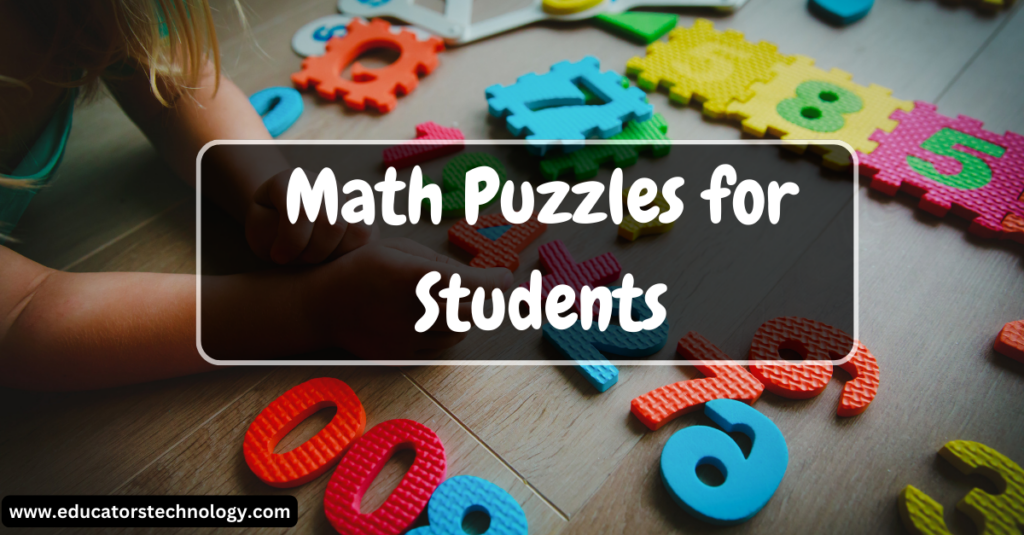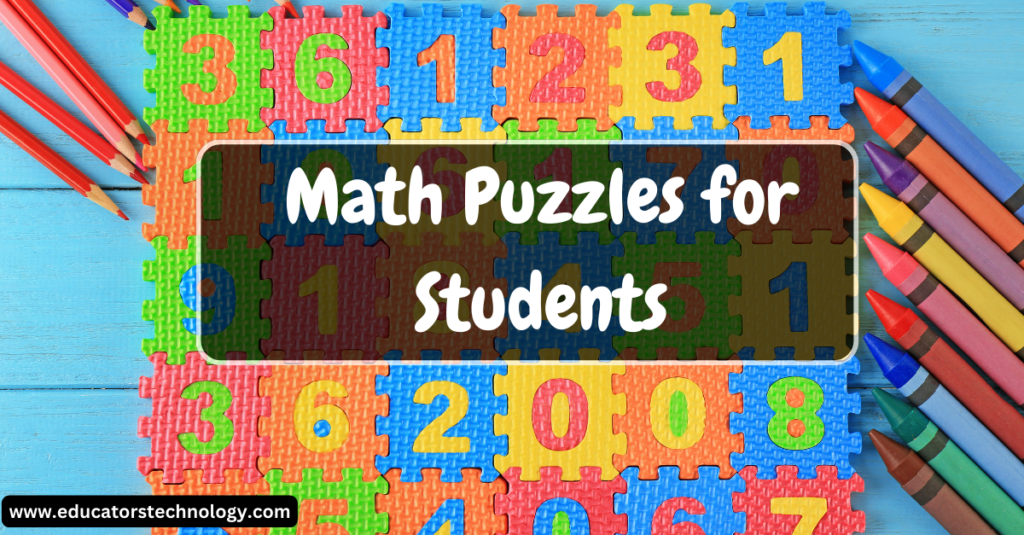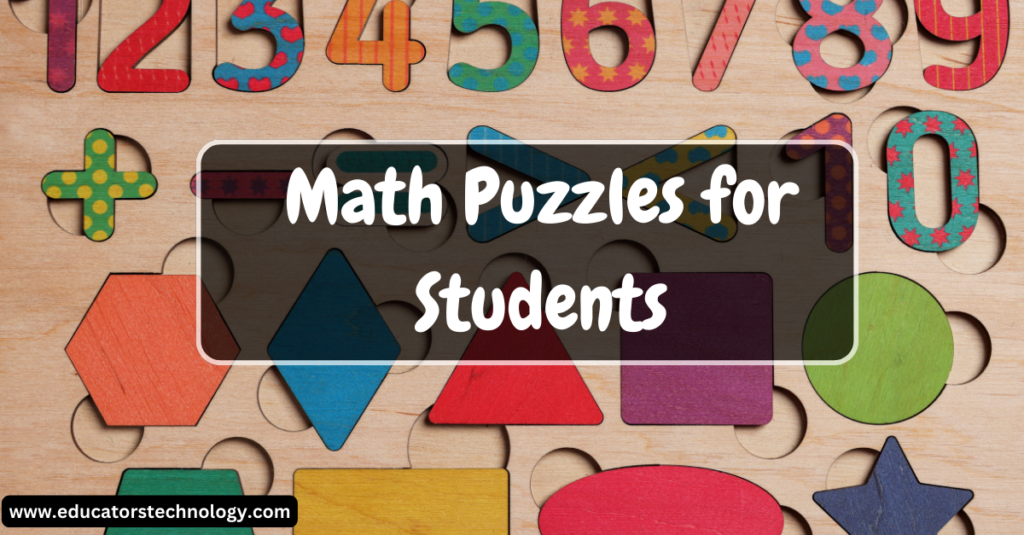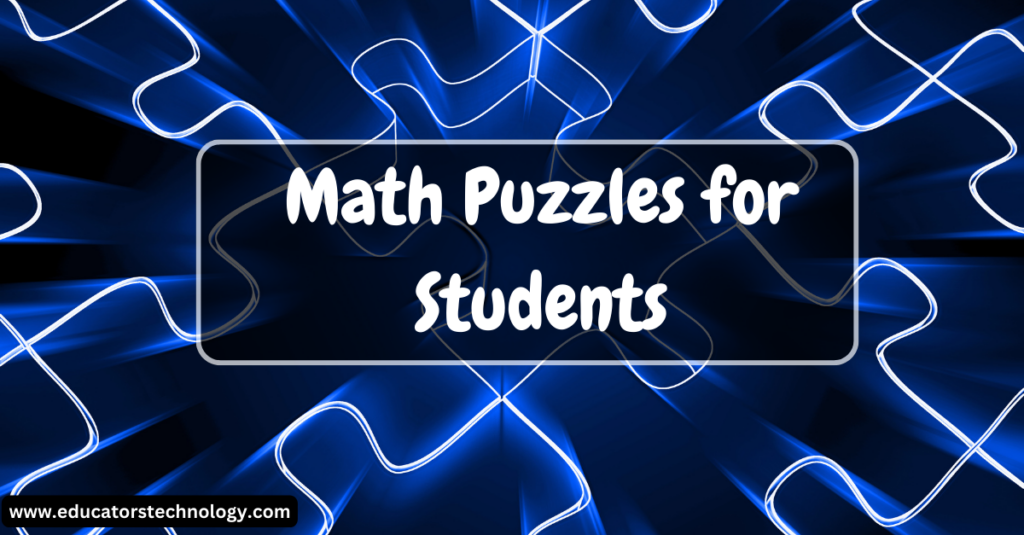TechGuruindia
Member
In a world increasingly driven by logic, data, and patterns, mathematical skills form the foundation of critical thinking and problem-solving capabilities. This statement isn’t just true for scientists and engineers, it’s for everyone.
Mathematics, in its many forms, is intricately woven into the fabric of our daily lives – from managing finances to baking a cake, from planning a trip to understanding global issues. The more we enhance our mathematical skills, the better we understand the world around us.

However, developing mathematical skills can often seem challenging and unengaging to many students. That’s where math puzzles step into the picture. They are more than just a fun pastime.
They’re an effective tool that makes learning an active process, ignites curiosity, and develops a deeper understanding of mathematical concepts. More importantly, they build critical life skills such as problem-solving, persistence, and logical reasoning.
In this blog post, we will explore the exciting world of math puzzles designed specifically for middle school students. You’ll discover why these puzzles are vital for learning, the types of puzzles that students find both engaging and beneficial, and how to integrate them into everyday learning.
We will also share some of our favorite math puzzles that are guaranteed to give your brain a good workout. So whether you’re a student looking for a challenge, a teacher seeking to invigorate your lesson plans, or a parent hoping to boost your child’s learning, you’re in the right place.
Puzzles are not just a source of fun and entertainment, but they’re a powerful educational tool, especially when it comes to learning mathematics. Here’s why:
Solving math puzzles stimulates the brain and enhances cognitive processes. They require the solver to apply different strategies and techniques, enhancing cognitive skills like critical thinking, problem-solving, spatial reasoning, and memory.
Furthermore, they enhance pattern recognition, a crucial aspect of mathematics, as students must identify patterns and sequences in numbers or shapes to solve puzzles.
One of the main challenges in teaching mathematics is to keep students engaged and motivated. Math puzzles turn abstract and sometimes intimidating concepts into stimulating challenges that students enjoy tackling.
Math puzzles transform the learning process into a game, reducing anxiety and boosting students’ willingness to engage with mathematical concepts. In fact, they often lead to those wonderful “Aha!” moments when a previously confusing concept suddenly makes perfect sense.

Math puzzles are an excellent tool to develop and reinforce essential mathematical skills. They require students to apply logical thinking, finding solutions through a process of deduction and elimination.
They foster creativity as there are often multiple ways to approach and solve a puzzle. Math puzzles also improve concentration as students must focus on the task at hand and ignore irrelevant information.
Moreover, math puzzles teach perseverance. Some puzzles may take time and multiple attempts to solve, teaching students the valuable lesson that persistence pays off, and it’s okay to make mistakes. This lesson is particularly important in mathematics, where students can often feel disheartened after a few unsuccessful attempts at solving problems.
Here are some common math puzzle types that are particularly suitable for middle school students, along with examples of each type.
Sudoku is a number puzzle where the objective is to fill a 9×9 grid with digits so that each column, each row, and each of the nine 3×3 sub-grids contain all of the digits from 1 to 9.
Sudoku puzzles develop logic and deduction skills as students must determine where each number fits in the grid. They also improve pattern recognition, as solving the puzzle depends on recognizing the distribution of numbers.
A magic square is a grid of numbers (usually positive integers) where the sums of the numbers in each row, each column, and both main diagonals are the same. Magic squares can range from simple 3×3 grids to more complex versions.
Solving magic squares requires knowledge of basic arithmetic and can enhance students’ numerical reasoning and problem-solving skills.
Logic puzzles present a situation and a series of clues, and the solver must deduce the correct outcome. They come in many forms, such as grid logic puzzles, spatial logic puzzles, or puzzles that involve logical sequencing.
These puzzles enhance critical thinking skills, as they require students to analyze clues, make deductions, and apply logical reasoning.
Number puzzles involve numerical calculations or manipulations. Examples include arithmetic crosswords, where students must solve basic arithmetic problems to fill in the crossword; number sequences, where students must deduce the rule that generates a sequence; or cryptarithms, where each letter represents a different digit. These puzzles develop arithmetic skills, understanding of mathematical operations, and pattern recognition.
Each of these puzzle types brings a unique flavor to the learning process, catering to different student preferences and learning styles. As students engage with various puzzles, they gain a broader understanding and appreciation of mathematics, making the subject more accessible and enjoyable.
Here are five math puzzles that middle school students will find both challenging and enjoyable:
Explanation: The Towers of Hanoi puzzle consists of three pegs and a set of differently sized disks that can be stacked on any peg. The goal is to move all the disks from one peg to another, following the rules that only one disk can be moved at a time, and a larger disk cannot be placed on top of a smaller disk.
Solution: The solution to the Towers of Hanoi puzzle involves recursive thinking and strategic planning.
Concept Developed: Logical thinking, problem-solving, and understanding recursive patterns.

Explanation: KenKen is a mathematical puzzle that combines elements of Sudoku and arithmetic operations. The puzzle consists of a grid divided into regions, with each region containing a target number and an arithmetic operation. The objective is to fill in the grid with numbers, following the rules of the arithmetic operation, so that each row and column contains unique numbers.
Solution: The solution to KenKen puzzles requires logical deduction and applying basic arithmetic operations.
Concept Developed: Arithmetic skills, logical thinking, and spatial reasoning.
Explanation: The Fibonacci Sequence is a series of numbers in which each number is the sum of the two preceding ones. The puzzle involves finding the next number in the sequence by adding the last two numbers. For example, if the sequence starts with 0 and 1, the next number would be 1 (0 + 1), then 2 (1 + 1), then 3 (1 + 2), and so on.
Solution: The solution to the Fibonacci Sequence puzzle is found by applying the rule of adding the last two numbers in the sequence to find the next number.
Concept Developed: Number patterns, problem-solving, and critical thinking.
Explanation: Math riddles are brain-teasing puzzles that require mathematical reasoning and clever thinking. These puzzles often present a situation or problem that needs to be solved using mathematical concepts, calculations, or logical deductions.
Solution: The solution to math riddles involves analyzing the given information, applying mathematical principles, and thinking creatively to find the answer.
Concept Developed: Critical thinking, problem-solving, and mathematical reasoning.
Explanation: Math crosswords are crossword puzzles where the clues are mathematical problems or equations. Students must solve the problems and fill in the crossword grid with the correct answers.
Solution: The solution to a math crossword is found by solving the mathematical problems given as clues and placing the correct answers in the crossword grid.
Concept Developed: Arithmetic skills, problem-solving, and mathematical vocabulary.
Explanation: Kakuro is a crossword puzzle that uses numbers. The puzzle consists of a grid with blank cells that need to be filled with digits from 1 to 9. The goal is to fill in the grid so that the sums of the numbers in each “clue” group (indicated by a sum and a length) match the given clues, without repeating digits within the same clue group.
Solution: The solution to a Kakuro puzzle requires logical deduction, number combinations, and careful consideration of the clue sums.
Concept Developed: Arithmetic skills, logical thinking, and problem-solving.
Explanation: Math lateral thinking puzzles are riddles or puzzles that require thinking outside the box and considering different perspectives to find the solution. These puzzles often involve mathematical scenarios or concepts but require unconventional thinking.
Solution: The solution to math lateral thinking puzzles requires creative problem-solving, critical thinking, and a willingness to explore alternative approaches.
Concept Developed: Creative thinking, problem-solving, and thinking beyond conventional approaches.
Explanation: Tangram puzzles involve rearranging geometric shapes to form specific figures or patterns. The puzzle provides a set of geometric shapes (called “tans”), and the challenge is to use all the shapes to recreate a given silhouette without overlapping.
Solution: The solution to a Tangram puzzle involves spatial reasoning, visual perception, and experimenting with different arrangements of the shapes.
Concept Developed: Geometry, spatial awareness, and visual problem-solving.
Explanation: Cryptarithms are mathematical puzzles where letters are used to represent digits in an arithmetic operation. The challenge is to determine the correct digit-letter substitution to make the equation valid.
Solution: The solution to a cryptarithm involves using logical deduction, trial and error, and mathematical reasoning to find the appropriate digit-letter substitutions.
Concept Developed: Algebraic thinking, logical deduction, and problem-solving.
Explanation: Math mazes combine mathematical problem-solving with a maze-solving challenge. The maze is filled with mathematical problems or equations, and students must solve the problems correctly to navigate through the maze and reach the goal.
Solution: The solution to a math maze requires solving the mathematical problems correctly to choose the correct path through the maze.
Concept Developed: Arithmetic skills, problem-solving, logical thinking, and spatial awareness.

Here are some websites that offer math puzzles for students:
Math puzzle books are a treasure trove of engaging and challenging puzzles designed to sharpen mathematical skills and foster a love for problem-solving. These books offer a diverse collection of puzzles, ranging from number games and logic puzzles to brain teasers and mathematical riddles.
The post appeared first on .
Mathematics, in its many forms, is intricately woven into the fabric of our daily lives – from managing finances to baking a cake, from planning a trip to understanding global issues. The more we enhance our mathematical skills, the better we understand the world around us.

However, developing mathematical skills can often seem challenging and unengaging to many students. That’s where math puzzles step into the picture. They are more than just a fun pastime.
They’re an effective tool that makes learning an active process, ignites curiosity, and develops a deeper understanding of mathematical concepts. More importantly, they build critical life skills such as problem-solving, persistence, and logical reasoning.
In this blog post, we will explore the exciting world of math puzzles designed specifically for middle school students. You’ll discover why these puzzles are vital for learning, the types of puzzles that students find both engaging and beneficial, and how to integrate them into everyday learning.
We will also share some of our favorite math puzzles that are guaranteed to give your brain a good workout. So whether you’re a student looking for a challenge, a teacher seeking to invigorate your lesson plans, or a parent hoping to boost your child’s learning, you’re in the right place.
Table of Contents
Why Puzzles are Important in Learning Math
Puzzles are not just a source of fun and entertainment, but they’re a powerful educational tool, especially when it comes to learning mathematics. Here’s why:
1. Cognitive Benefits of Solving Math Puzzles
Solving math puzzles stimulates the brain and enhances cognitive processes. They require the solver to apply different strategies and techniques, enhancing cognitive skills like critical thinking, problem-solving, spatial reasoning, and memory.
Furthermore, they enhance pattern recognition, a crucial aspect of mathematics, as students must identify patterns and sequences in numbers or shapes to solve puzzles.
2. Making Learning Fun and Engaging
One of the main challenges in teaching mathematics is to keep students engaged and motivated. Math puzzles turn abstract and sometimes intimidating concepts into stimulating challenges that students enjoy tackling.
Math puzzles transform the learning process into a game, reducing anxiety and boosting students’ willingness to engage with mathematical concepts. In fact, they often lead to those wonderful “Aha!” moments when a previously confusing concept suddenly makes perfect sense.

3. Enhancing Essential Mathematical Skills
Math puzzles are an excellent tool to develop and reinforce essential mathematical skills. They require students to apply logical thinking, finding solutions through a process of deduction and elimination.
They foster creativity as there are often multiple ways to approach and solve a puzzle. Math puzzles also improve concentration as students must focus on the task at hand and ignore irrelevant information.
Moreover, math puzzles teach perseverance. Some puzzles may take time and multiple attempts to solve, teaching students the valuable lesson that persistence pays off, and it’s okay to make mistakes. This lesson is particularly important in mathematics, where students can often feel disheartened after a few unsuccessful attempts at solving problems.
Types of Math Puzzles
Here are some common math puzzle types that are particularly suitable for middle school students, along with examples of each type.
1. Sudoku
Sudoku is a number puzzle where the objective is to fill a 9×9 grid with digits so that each column, each row, and each of the nine 3×3 sub-grids contain all of the digits from 1 to 9.
Sudoku puzzles develop logic and deduction skills as students must determine where each number fits in the grid. They also improve pattern recognition, as solving the puzzle depends on recognizing the distribution of numbers.
2. Magic Squares
A magic square is a grid of numbers (usually positive integers) where the sums of the numbers in each row, each column, and both main diagonals are the same. Magic squares can range from simple 3×3 grids to more complex versions.
Solving magic squares requires knowledge of basic arithmetic and can enhance students’ numerical reasoning and problem-solving skills.
3. Logic Puzzles
Logic puzzles present a situation and a series of clues, and the solver must deduce the correct outcome. They come in many forms, such as grid logic puzzles, spatial logic puzzles, or puzzles that involve logical sequencing.
These puzzles enhance critical thinking skills, as they require students to analyze clues, make deductions, and apply logical reasoning.
4. Number Puzzles
Number puzzles involve numerical calculations or manipulations. Examples include arithmetic crosswords, where students must solve basic arithmetic problems to fill in the crossword; number sequences, where students must deduce the rule that generates a sequence; or cryptarithms, where each letter represents a different digit. These puzzles develop arithmetic skills, understanding of mathematical operations, and pattern recognition.
Each of these puzzle types brings a unique flavor to the learning process, catering to different student preferences and learning styles. As students engage with various puzzles, they gain a broader understanding and appreciation of mathematics, making the subject more accessible and enjoyable.
Examples of Math Puzzles for Middle School Students
Here are five math puzzles that middle school students will find both challenging and enjoyable:
1. Towers of Hanoi
Explanation: The Towers of Hanoi puzzle consists of three pegs and a set of differently sized disks that can be stacked on any peg. The goal is to move all the disks from one peg to another, following the rules that only one disk can be moved at a time, and a larger disk cannot be placed on top of a smaller disk.
Solution: The solution to the Towers of Hanoi puzzle involves recursive thinking and strategic planning.
Concept Developed: Logical thinking, problem-solving, and understanding recursive patterns.

2. KenKen
Explanation: KenKen is a mathematical puzzle that combines elements of Sudoku and arithmetic operations. The puzzle consists of a grid divided into regions, with each region containing a target number and an arithmetic operation. The objective is to fill in the grid with numbers, following the rules of the arithmetic operation, so that each row and column contains unique numbers.
Solution: The solution to KenKen puzzles requires logical deduction and applying basic arithmetic operations.
Concept Developed: Arithmetic skills, logical thinking, and spatial reasoning.
3. Fibonacci Sequence Puzzle
Explanation: The Fibonacci Sequence is a series of numbers in which each number is the sum of the two preceding ones. The puzzle involves finding the next number in the sequence by adding the last two numbers. For example, if the sequence starts with 0 and 1, the next number would be 1 (0 + 1), then 2 (1 + 1), then 3 (1 + 2), and so on.
Solution: The solution to the Fibonacci Sequence puzzle is found by applying the rule of adding the last two numbers in the sequence to find the next number.
Concept Developed: Number patterns, problem-solving, and critical thinking.
4. Math Riddles
Explanation: Math riddles are brain-teasing puzzles that require mathematical reasoning and clever thinking. These puzzles often present a situation or problem that needs to be solved using mathematical concepts, calculations, or logical deductions.
Solution: The solution to math riddles involves analyzing the given information, applying mathematical principles, and thinking creatively to find the answer.
Concept Developed: Critical thinking, problem-solving, and mathematical reasoning.
5. Math Crosswords
Explanation: Math crosswords are crossword puzzles where the clues are mathematical problems or equations. Students must solve the problems and fill in the crossword grid with the correct answers.
Solution: The solution to a math crossword is found by solving the mathematical problems given as clues and placing the correct answers in the crossword grid.
Concept Developed: Arithmetic skills, problem-solving, and mathematical vocabulary.
6. Kakuro
Explanation: Kakuro is a crossword puzzle that uses numbers. The puzzle consists of a grid with blank cells that need to be filled with digits from 1 to 9. The goal is to fill in the grid so that the sums of the numbers in each “clue” group (indicated by a sum and a length) match the given clues, without repeating digits within the same clue group.
Solution: The solution to a Kakuro puzzle requires logical deduction, number combinations, and careful consideration of the clue sums.
Concept Developed: Arithmetic skills, logical thinking, and problem-solving.
7. Math Lateral Thinking Puzzles
Explanation: Math lateral thinking puzzles are riddles or puzzles that require thinking outside the box and considering different perspectives to find the solution. These puzzles often involve mathematical scenarios or concepts but require unconventional thinking.
Solution: The solution to math lateral thinking puzzles requires creative problem-solving, critical thinking, and a willingness to explore alternative approaches.
Concept Developed: Creative thinking, problem-solving, and thinking beyond conventional approaches.
8. Tangram Puzzles
Explanation: Tangram puzzles involve rearranging geometric shapes to form specific figures or patterns. The puzzle provides a set of geometric shapes (called “tans”), and the challenge is to use all the shapes to recreate a given silhouette without overlapping.
Solution: The solution to a Tangram puzzle involves spatial reasoning, visual perception, and experimenting with different arrangements of the shapes.
Concept Developed: Geometry, spatial awareness, and visual problem-solving.
9. Cryptarithms
Explanation: Cryptarithms are mathematical puzzles where letters are used to represent digits in an arithmetic operation. The challenge is to determine the correct digit-letter substitution to make the equation valid.
Solution: The solution to a cryptarithm involves using logical deduction, trial and error, and mathematical reasoning to find the appropriate digit-letter substitutions.
Concept Developed: Algebraic thinking, logical deduction, and problem-solving.
10. Math Maze
Explanation: Math mazes combine mathematical problem-solving with a maze-solving challenge. The maze is filled with mathematical problems or equations, and students must solve the problems correctly to navigate through the maze and reach the goal.
Solution: The solution to a math maze requires solving the mathematical problems correctly to choose the correct path through the maze.
Concept Developed: Arithmetic skills, problem-solving, logical thinking, and spatial awareness.

Math Puzzles websites
Here are some websites that offer math puzzles for students:
- : Math Playground provides a wide range of math games and puzzles, including logic puzzles, word problems, and number puzzles, suitable for middle school students.
- : Hooda Math offers a collection of interactive math games and puzzles that cover various topics, such as algebra, geometry, and logic. Students can choose from a variety of puzzles to challenge their problem-solving skills.
- : Math is Fun features a section dedicated to math puzzles and games. Students can explore a variety of puzzles, brain teasers, and interactive games that cover different math concepts and challenge their thinking abilities.
- : Coolmath.com offers a section specifically for middle school math puzzles. Students can find puzzles, brain teasers, and interactive activities that are both educational and entertaining.
- : This is a collection of websites that offer a wide variety of math games and puzzles for students of all ages and grade levels.
Math Puzzle Books
Math puzzle books are a treasure trove of engaging and challenging puzzles designed to sharpen mathematical skills and foster a love for problem-solving. These books offer a diverse collection of puzzles, ranging from number games and logic puzzles to brain teasers and mathematical riddles.
- Math Puzzles and Brainteasers, Grades 6-8: Over 300 Puzzles that Teach Math and Problem-Solving Skills, by Terry Stickels
- Math Puzzles Volume 1: Classic Riddles and Brain Teasers In Counting, Geometry, Probability, And Game Theory, by Presh Talwalkar
- The Original Area Mazes: 100 Addictive Puzzles to Solve with Simple Math—and Clever Logic! by Naoki Inaba et al
- 100 Math Brainteasers (Grade 7, 8, 9, 10). Arithmetic, Algebra and Geometry Brain Teasers, Puzzles, Games and Problems with Solutions, by Zbigniew Romanowicz, Bartholomew Dyda
- 100 Puzzle Quizzes (Interactive Puzzlebook for E-readers, by The Grabarchuk Family
- The Moscow Puzzles: 359 Mathematical Recreations, by B. A. Kordemskiĭ
- 300+ Mathematical Pattern Puzzles: Number Pattern Recognition & Reasoning, by Chris McMullen
- The Best Mental Math Tricks, by Presh Talwalkar
- 75 amazing logic riddles and games: Answers just one click away, by M. S. Collins
- Riddles: 100 Interactive Riddles and Brain teasers, by Puzzleland (Author), Beatrice Wood
The post appeared first on .
